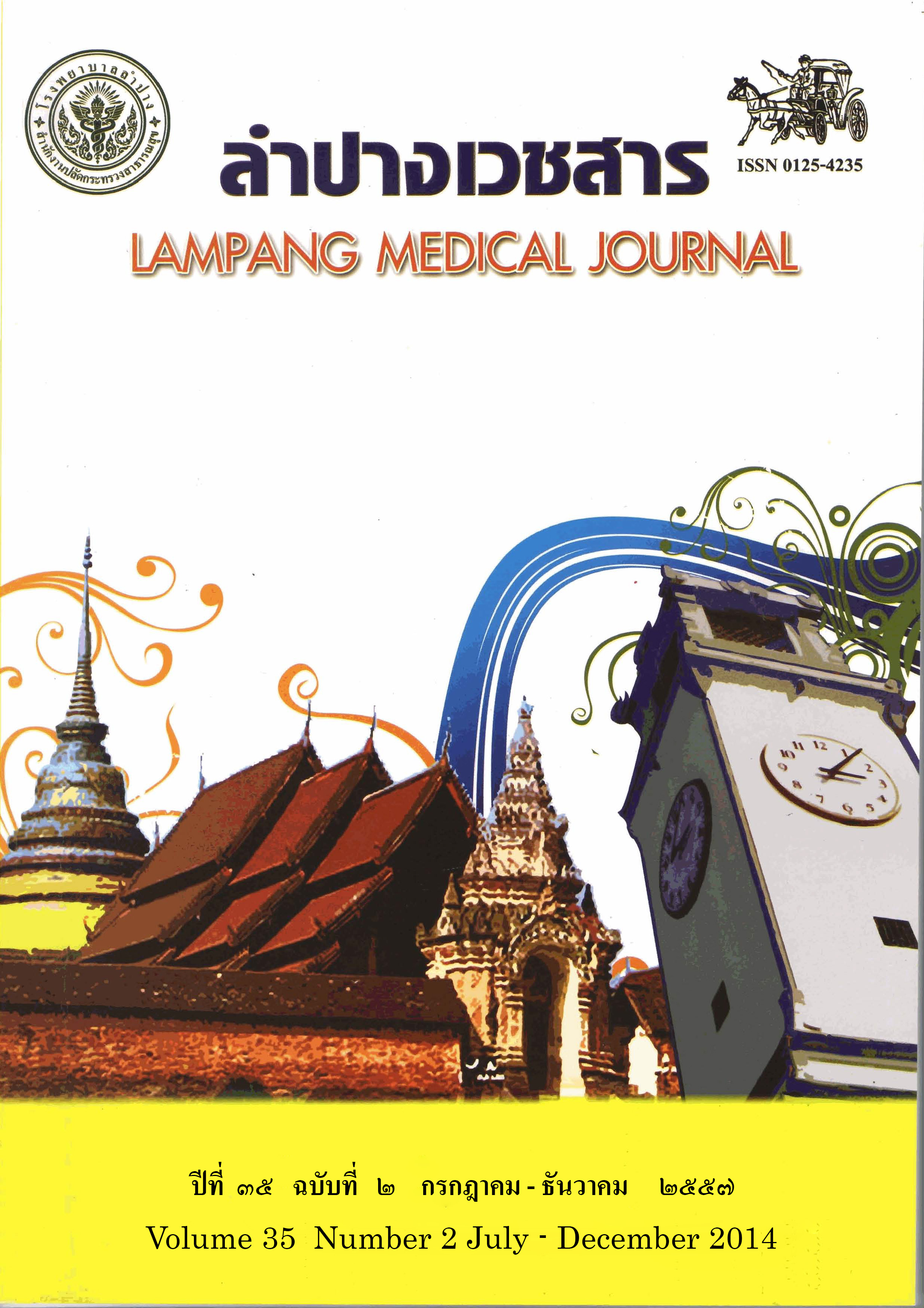Results of Anesthetic and Airway Management of Patients with Deep Neck Space Infection in Lampang Hospital
Main Article Content
Abstract
Background: Deep neck space infection is challenging to anesthesiologist for coping with upper airway obstruction and difficult intubation.
Objective: To explore anesthetic techniques and results of airway management in patients with deep neck space infection who underwent surgical drainage and determine the factors related to intubation difficulty.
Material and method: A retrospective analytical study was conducted on surgical patients with deep neck space infection who received general anesthesia in Lampang Hospital during June 2009-August 2014. Clinical and anesthetic data were analyzed by using descriptive statistics. Factors associated with difficult or failed intubation, retained intubation and length of stay were analyzed with Fisher’s exact probability test and one-way ANOVA.
Results: Among 73 patients in the study, 69.9% were male and the mean age was 53.4±14.3 years (range 20-82). Most of infection sites were suprahyoid neck space (56.2 %) and Ludwig’s angina (20.6%). The most common techniques for airway management were direct laryngoscopy (67.1%) and fiberoptic intubation (23.3%). Three patients underwent tracheostomy. Retained intubation was found in 46 cases and most of them (26 cases) were extubated in the first postoperative day. The mean length of stay was 9.5 ± 4.8 day (range 1-33) without significant difference between tracheostomy and endotracheal intubation groups. ASA physical status class 3-4, limited mouth opening and difficult intubation were risks factors for retained intubation. No statistically significant factors were associated with difficult or failed intubation by direct laryngoscopy.
Conclusion: Intravenous induction and intubation by direct laryngoscopy with succinylcholine was the most common anesthetic and airway management technique used this study. There were no statistically significant factors associated with difficult or failed intubation by this technique.
Article Details

This work is licensed under a Creative Commons Attribution-NonCommercial-NoDerivatives 4.0 International License.
บทความที่ส่งมาลงพิมพ์ต้องไม่เคยพิมพ์หรือกำลังได้รับการพิจารณาตีพิมพ์ในวารสารอื่น เนื้อหาในบทความต้องเป็นผลงานของผู้นิพนธ์เอง ไม่ได้ลอกเลียนหรือตัดทอนจากบทความอื่น โดยไม่ได้รับอนุญาตหรือไม่ได้อ้างอิงอย่างเหมาะสม การแก้ไขหรือให้ข้อมูลเพิ่มเติมแก่กองบรรณาธิการ จะต้องเสร็จสิ้นเป็นที่เรียบร้อยก่อนจะได้รับพิจารณาตีพิมพ์ และบทความที่ตีพิมพ์แล้วเป็นสมบัติ ของลำปางเวชสาร
References
วิชาญ จงประสาธน์สุข. การศึกษาผู้ป่วยติดเชื้อของเยื่อหุ้มชั้นลึกบริเวณคอ 127 รายในโรงพยาบาลน่าน. ลำปางเวชสาร 2554;32(2):42-50.
Ovassapian A, Tuncbilek M, Weitzel EK, Joshi CW. Airway management in adult patients with deep neck infections: a case series and review of the literature. Anesth Analg 2005;100(2):585-9.
Oliver ER, Gillespie MB. Deep neck space infection. In:Flint PW, Haughey BH, Lund VJ, et al., editors. Cummings otolaryngology-head and neck surgery. 5th ed. Philadelphia:Mosby Elsevier; 2010. p 201-8.
Klock PA Jr, Benumof JL. Definition and incidence of the difficult airway. In: Hagberg CA, editor. Benumof’s airway management: principles and practice. 2nd ed. Philadelphia: Mosby Elsevier; 2007. p 215-20.
Wolfe MM, Davis JW, Parks SN. Is surgical airway necessary for airway management in deep neck infections and Ludwig angina?. J Crit Care 2011;26(1):11-4.
Neff SPW, Merry AF, Anderson B. Airway management in Ludwig’s angina. Anaesth Intens Care 1999;27(6):659-61.
Karkos PD, Leong SC, Beer H, Apostolidou MT, Panarese A. Challenging airways in deep neck space infections. Am J Otolaryngol 2007;28(6):415-8.
Gidley P, Ghorayeb B, Stiernberg C. Contemporary management of deep neck space infections. Otolaryngol Head Neck Surg 1997;116(1):16-22.
Potter JK, Herford AS, Ellis E. Tracheotomy versus endotracheal intubation for airway management in deep neck space infections. J Oral Maxillofac Surg 2002;60:349-54.
Loughnan TE, Allen DE. Ludwig’s angina: the anaesthetic management of nine cases. Anaesthesia 1985;40:295-7.


